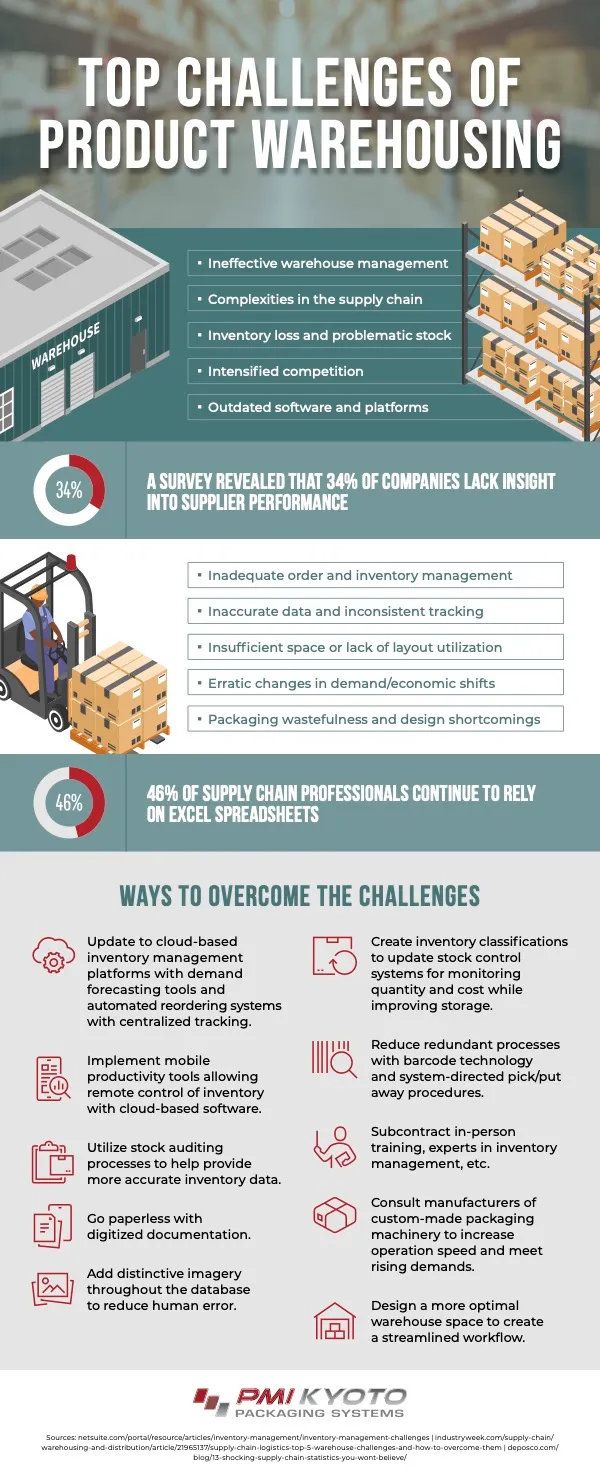Top Challenges Of Product Warehousing: What Businesses Need To Know
July 14, 2025

Warehousing plays a critical role in supply chain performance. It affects product availability, order accuracy, and overall efficiency. While warehousing operations may seem straightforward, many businesses face ongoing challenges that impact productivity, cost control, and customer satisfaction. Identifying these challenges is the first step in developing solutions that improve performance and support long-term growth.
Key Takeaways On Top Challenges of Product Warehousing
- Inadequate Space: Insufficient warehouse space can lead to storage inefficiencies, increased handling costs, and difficulty in managing inventory effectively.
- Inefficient Layout: A poorly designed warehouse layout can result in wasted space, longer travel times for workers, and bottlenecks in the picking and packing processes.
- Inventory Management Issues: Poor inventory control can lead to stockouts, overstocking, and inaccurate demand forecasting, resulting in increased costs and reduced customer satisfaction.
- Labor Shortages: Difficulty in attracting and retaining qualified warehouse staff can lead to increased labor costs, reduced productivity, and errors in order fulfillment.
- Technology Adoption: Failure to adopt modern warehouse technologies can result in inefficiencies, errors, and a lack of real-time visibility into warehouse operations.
- Supply Chain Disruptions: Unexpected disruptions in the supply chain can lead to delays, increased costs, and difficulty in meeting customer demand.
- Rising Costs: Increasing costs related to labor, transportation, and storage can impact profitability and competitiveness.
Register Your LLC
Company Registration
START NOW
Inventory Inaccuracy and Tracking Issues
Inventory accuracy is essential for meeting demand and avoiding costly errors. Discrepancies between physical stock and inventory records can result in stockouts, overstocking, or delayed shipments. These issues often stem from manual data entry, inconsistent processes, or failure to update systems in real time. Barcode scanners and warehouse management systems (WMS) can help reduce human error, but they require consistent use and regular maintenance to remain effective.
Space Utilization and Storage Efficiency
Limited space is a frequent concern in warehousing, particularly for businesses experiencing seasonal peaks or rapid growth. Poor space utilization leads to disorganized inventory, longer picking times, and higher operational costs. Rethinking layout design, implementing vertical storage solutions, and categorizing products by turnover rates can help optimize available space. Flexible racking systems and clearly defined zones also contribute to more efficient storage and retrieval.
Labor Management and Workforce Turnover
Warehouses depend heavily on manual labor for picking, packing, and loading tasks. Staffing shortages, inconsistent training, and high employee turnover can disrupt workflows and increase errors. Labor shortages may be more acute in regions with limited available workforce or during peak demand periods. Investing in staff augmentation, cross-training and streamlining repetitive tasks with automation can help reduce reliance on a large labor pool.
Technology Integration and System Compatibility
Many warehouses use a combination of legacy systems and newer technologies, which can create problems with integration. Disconnected platforms hinder real-time visibility and data sharing. Ensuring that inventory software, order management systems, and other technologies work together smoothly is essential for maintaining operational flow. Companies must also plan for system updates and user training to keep technology working effectively.
Product Handling and Damage Prevention
Proper handling procedures are vital to prevent damage during storage and movement. Fragile, perishable, or high-value products require specific storage conditions and handling protocols. Damage can occur due to poor stacking methods, inadequate storage environments, or improper use of equipment. Packaging equipment plays a role in protecting goods by ensuring they are securely prepared for storage or transport. Routine inspection of pallets, shelving, and handling tools helps maintain safety standards and prevent loss.
Order Accuracy and Fulfillment Speed
Consumers and business clients expect timely, accurate deliveries. Errors in picking, packing, or shipping can damage customer relationships and increase return rates. Warehouses must balance speed with precision, particularly during high-volume periods. Clear workflows, real-time tracking, and periodic audits help maintain fulfillment accuracy. Prioritizing accuracy over volume may seem counterintuitive, but it often leads to improved long-term performance.
Effective warehousing demands attention to detail, process consistency, and strategic use of space and labor. Addressing these common challenges can lead to better service levels, reduced waste, and stronger supply chain performance. To learn more, look over the accompanying infographic below.


